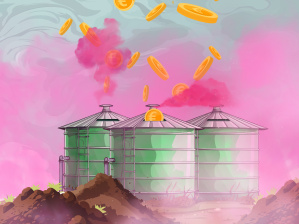Hot Money: 40 Financial Institutions are funding a climate-changing agri-methane footprint

Executive Summary
20 INVESTORS and 20 BANKS are funding the methane generating activities of 15 of the leading meat and dairy companies worldwide
This report focuses on the 20 investors and 20 banks that are funding the methane generating activities of 15 of the leading meat and dairy companies worldwide. Collectively these financial institutions fund a methane footprint that could exceed 503 Mt CO2e – nearly as big as the CO2 emissions of Saudi Arabia.
The policy frameworks disclosed by these financial institutions are weak or non-existent. Not only are they at odds with the Global Methane Pledge signed by their home countries, the financial institutions do not disclose the methane emissions that their funding supports.
The aggregate agri-methane footprint attributable to the top 20 equity investors in these 15 meat and dairy companies is 68 Mt CO2e of methane – more than the CO2 emissions of Austria. Vanguard takes first place, with BlackRock second and State Street third. The following asset managers rank outside the top 50 globally i in terms of their size but feature in our top 20 equity holders: Zürcher Kantonalbank (Asset Management), Hohhot Investment Company Ltd., Artisan Partners Asset Management Inc., Pictet & Group SCA Cie, and First Eagle Holdings Inc.
The agri-methane footprint attributable to the top 20 banks funding these 15 meat and dairy companies is 202.5 Mt CO2e – roughly three times the investors’ footprint and nearly as large as the CO2 footprint of countries like Spain. Because of its focus on meat, Morgan Stanley takes the top slot, followed by JP Morgan and HSBC.
The more conservative ‘equal responsibility’ estimation method would suggest a footprint for the banks of 434.9 Mt CO2e.
PARTNERS
You might also like...

Biogas in the EU: A policy and financial analysis – Profundo report
A policy and financial analysis by Profundo of EU policies and the policies of the UK, Denmark, Germany, Ireland, the Netherlands, Poland and Romania, commissioned by the Methane Matters Coalition.

Methane Matters: Towards a global methane agreement
At the 2021 Climate Change Conference, over 110 countries joined a pledge to reduce global methane emissions by 30% by 2030. This crucial commitment under the ‘Global Methane Pledge’ came at a time of scient...

The New Merchants of Doubt: How Big Meat and Dairy Avoid Climate Action
This report reveals the tactics of Big Meat and Dairy companies to delay, distract, and derail action on transforming the food system, mirroring strategies used by the tobacco and fossil fuel industries.